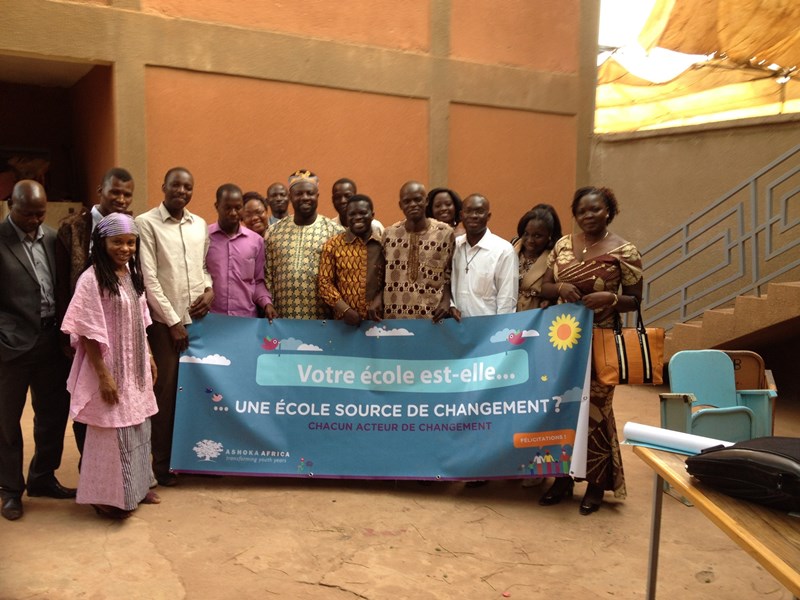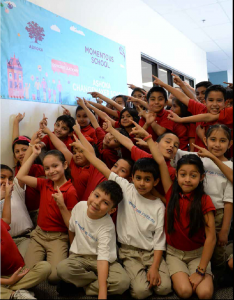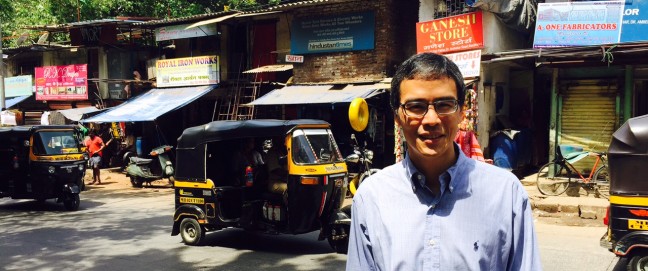Bill Drayton founded Ashoka: Innovators for the Public 34 years ago. In the intervening years, the pace of change has accelerated rapidly, producing what he describes as a society based on innovation, rather than repetition. It’s never too early to begin adapting to this, he says; in fact, the earlier the better. The rising generation needs to master what he describes as cognitive empathy-based living and three other social skills needed to become a changemaker. That’s why Ashoka has launched its Youth Venture programme and is championing schools that help inculcate those skills. In the future, learning these skills will not be a matter of choice, he told Caroline Hartnell when they met at the recent Skoll World Forum in Oxford.
We last did an interview in 2000. Since then, Ashoka has developed many new initiatives, including the Youth Venture programme and the Ashoka Support Network, which I gather involves business. So can you tell me a bit about where you are now?
On that last point first, we’ve always understood that the top pattern-change business entrepreneurs who want to have as big an impact socially as they have had in business are, along with our leading social entrepreneur Fellows and our staff, our closest partners. All three groups are entrepreneurs, committed to the good of all. (That’s a definition that transcends sectors.) This combination is the core of something that’s much bigger. The Ashoka Support Network is a part of that.‘Most of those working in both the business and social sectors are not entrepreneurs. Of those who are, there’s a subset that are both entrepreneurs and really committed to the good of all.’
But you’re not saying that all business people are business entrepreneurs?
Most of those working in both the business and social sectors are not entrepreneurs. Of those who are, there’s a subset that are both entrepreneurs and really committed to the good of all. That’s who we look for. This definitional point is important: social entrepreneurs aim to bring about pattern change and/or mindset change. This is different from direct service. We know direct service statistics for the Ashoka Fellows, but we never use them. Instead we ask what proportion have changed national policy five years after launch, which is about 55 per cent. What proportion have changed the patterns in their fields? Three quarters, within five years, nationally. And over 90 per cent have had independent institutions copy their innovations in the same five years. Those are all measures of pattern change.
Beyond direct service and pattern change, there is the third and highest leveraged dimension of impact – mindset or framework change. Ashoka’s first framework change success was working to introduce the word and concept of social entrepreneurship. Now we are working to help the world see that it is at the turning point from a world of repetition to a world of change. This requires a dramatically different way of organizing, and it also requires everyone to have a very different set of skills.
That’s where Ashoka’s Youth Venture comes in, is it not?
Yes! In a world where the demand for intellectual as well as physical repetition is declining as rapidly as the demand for people who can contribute to change is accelerating, this generation of young people must develop the skills and self-definition to be changemakers as young people.
That means that a very young person must practise and practise being a changemaker. This is the only way to develop the four skills essential to this new era: cognitive empathy-based living, sophisticated teamwork, a very different type of leadership, and changemaking itself. When you see a young person who has had their own idea, built their own team and changed their school or some other community, it’s so powerful. They know that they can change the world because they just did. That’s exceptional at the moment, but what we want is for it to become the norm for every middle and high school student.‘That means that a very young person must practise and practise being a changemaker.’
Let me tell you a story. Ashoka’s Youth Venture has about 12,000 young people doing exactly what we’re describing. I was at a US Youth Venture meeting of about 350 young people and was sitting down at lunch when a very tiny young woman came over and sat down to my right. She introduced herself and said ‘I’m 12’, no doubt because she hates people assuming that she’s 8. I asked her what her venture was and she said, ‘My brother’s autistic and all through school I would cry when he was mistreated, and now we have fixed that.’ ‘How did you do that?’ ‘Well, we get together whenever we see a special student being mistreated, and we figure out how to intervene and then we do and we’re very persistent.’
If you had been there, you would not have any doubt that this young woman is a changemaker – and she knows it. She’s brought a whole team of other kids along with her; they’re practising empathy and teamwork, and they’re starting to get the idea that they can lead. She’s contributing to a culture in that school that makes this easier for other kids.
So I asked her one more question. ‘How many student groups are there in Shirley Middle School?’ – which, parenthetically, is a poor, rural school. ‘Oh, over 50.’ That’s incredibly rare. What happened when she joined Shirley was that she walked into an ‘everyone a changemaker’ culture that said to her, ‘You figure out a solution, build a team, and change this world. That’s the way our world works. Being a changemaker is the norm, not something hard and strange.’ So she did just that – with the result that at 12, she had her PhD in the most important skills she will need in a world being defined by change, not repetition. Our goal is that every young person practises these skills and that every middle and high school has, like Shirley Middle School, such an ‘everyone a changemaker’ culture.
To get back to the measures of mindset change, the first critical impact measure is: what proportion of students in a school know they’re changemakers? Key verb: know. And you can compare this over time and between classes, schools, cities and so on.
The second mindset impact measure is: what proportion of the stakeholders in this school know that the success or failure of their school turns centrally on whether they have an ‘everyone a changemaker’ culture in their school? Right now the numbers are extremely low, but because of Ashoka’s Youth Venture we’ve seen this change take place in many schools, so we know it’s not terribly difficult. And we can see and measure the impact.
‘To come back to definitions, social entrepreneurs are entrepreneurs for the good of all, whether they do it through a business or not.’
To come back to definitions, social entrepreneurs are entrepreneurs for the good of all, whether they do it through a business or not. People come from historically different ecosystems but the walls between those ecosystems are going away because, in a world of change, there is one new opportunity after another, and each requires creating a new team of teams, drawing from wherever you can the skills that you need for this new service.
There’s a very different emphasis in what you do and what Skoll does. Here at Skoll, a few outstanding individuals are celebrated, and at Ashoka you have thousands of Fellows and this ‘everyone a change maker’ mantra. How do the two relate to each other?
Skoll has made huge contributions to the field, very specifically including its celebration of social entrepreneurship.
Once people understand that social entrepreneurship is as real and practical as banking or teaching or any of the other older fields, they have a new possibility in their heads, a new idea of what they can do with their lives: they can go ahead and organize for the good of all, and this is both practical and attractive. That’s truly empowering. OK, you might not change the pattern in your field, but you can change the pattern in your town, or in your industry or church or whatever. The top-level social entrepreneurs Skoll celebrates are great models for this role.
So the Skoll celebration provides visibility and an increasing recognition of the idea of a social entrepreneur?
Yes! And that’s very empowering to millions of people who can be changemakers, even if far fewer will be entrepreneurs.
There’s another thing that’s very important here and that is that social entrepreneurs have a different structure typically from business or government. You have the entrepreneur; you have the organization, which is commonly of modest size; and then you have a very big movement. The social entrepreneur makes his/her idea as simple and understandable and safe as possible, precisely so that thousands of local people will stand up and say, ‘Oh that’s a very good idea, we need that here, we’re going to make that happen here – and we can see how to do it.’
So every leading social entrepreneur is a mass recruiter and facilitator of local changemakers, who in turn become local role models for changemaking. Mindset change is about getting the whole of society to see a new potential. Encouraging local changemakers provides the local pervasive leadership that helps get there. It’s actually a very coherent whole.
As you move into this ‘everyone a changemaker’ world, every time you set out to do something, you have to build a team of teams to get it done. That team of teams will change quickly and it will eventually cease to exist because that activity is no longer needed.
When we say we want to introduce a new paradigm of growing up, where every young person practises the four skills, getting that to happen is a four-step process. First, you set up the trigger: what is the lowest number of ‘forces’ that you need to set in motion to create a self-multiplying dynamic? In this case we think the trigger consists of co-leadership by Ashoka Fellows, a small number of journalists and publishers who grasp that this is the big news story of our era, and a certain number of representative schools.
There are three such ‘changemaker schools’ in the UK at the moment, and we are selecting more. We just inaugurated one here in Oxford yesterday. We also have a state school in Manchester and Atlantic College in South Wales, which is a United World College school, not a state school. The point is you need representation from the different types of school. There are 60 in the US because we started three years ago. From each such changemaker school, we get a team of people who are ready to play on the big mindset change playing field to get the whole society there.‘So every leading social entrepreneur is a mass recruiter and facilitator of local changemakers, who in turn become local role models for changemaking.’
Then you get to the next stage where you need wholesale partners – teacher colleges, professional organizations and teachers’ unions are three examples. And you also need in this stage to open up to anyone – eg any parent or any young person – so that they have access to all the thinking and tools, they can contribute as well, and they can find one another.
The third stage is the tipping years, where millions of people realize something is going on and they have to pay attention, so they look at Alliance or The Economist and find the stories that help them figure it out.
The fourth phase is institutionalization – making sure the new social order is served well organizationally. For example, what systems will keep it evolving flexibly and wisely as all around it keeps changing? What safeguards need to be built in, and what incentives will be needed to ensure necessary functions will be well staffed?
Now we’re building the team of teams to help us all see our way through this profound turning point.
So, going back to the changemaker schools, you’re not setting up new schools, you’re establishing a different ethos within existing schools?
That’s right. We’re choosing schools that are already sympathetic. We can contribute new language and new ideas, and we can connect them with a community of like-minded schools in their country and globally and with the other actors – notably with the 750 Ashoka Fellows who have large-scale, proven, effective experience of how to do this, eg how to help children grasp empathy.
Every school’s leadership team contributes ideas. For example, one of the Washington DC changemaker schools turned Service Day into Changemaking Day. This is really simple. Instead of, for example, following a teacher out to clean up the yard, every class in that school, starting with the first grade, tries to figure out a problem – for example, the janitor’s wife is ill – and what to do about it, and they then have to go and do it. That idea from one school has now been picked up by schools across Washington and is moving out to other parts.
How many changemaker schools have you got now in different countries?
I’m not absolutely sure because the number is growing fast, but it’s about 140.
And going to stage three, how far ahead do you see the tipping point?
I think we’re four to six years from the stage when everyone really sees that we’re living in an ‘everyone a changemaker’ world; that we have to organize differently; that we must all have very different skills. And if this generation of children and young people don’t have these social skills, they’re absolutely out of it, because any one particular skill is going to be obsolete. Moreover, no one will care how much astrophysics you know if you can’t play this game. This is the first generation of kids who, by the time they’re 25 or 30, won’t have the choice to play the old game.
I can see the attraction, but are we really going to get to it?
It’s here. Silicon Valley, Bangalore, those are ecosystems organized this way. The Jesuits, 490 years ago, set up an ‘everyone a changemaker’ island; that’s why they’re so powerful. It’s not an accident that we now have the first Jesuit pope in history. The church intuitively knows that it has to move, and it has now turned to what was long sensed to be a very foreign entity inside the church. There are more and more ‘everyone a changemaker’ examples all around us.
We really don’t have a choice. We can choose to be a national Detroit and miss the turning point. Detroit was the top of the American economy, technology, wealth and pride, and now it’s broke, has lost 25 per cent of its population in ten years, and will have to spend one billion dollars to tear down 40 per cent of the remaining buildings because they’re unrecoverable. These turning points happen really quickly. It is truly important for everyone to see it and move with it. So our job is to help everyone see it – every family, every school, every community.
For more information
http://www.ashoka.org










Comments (0)